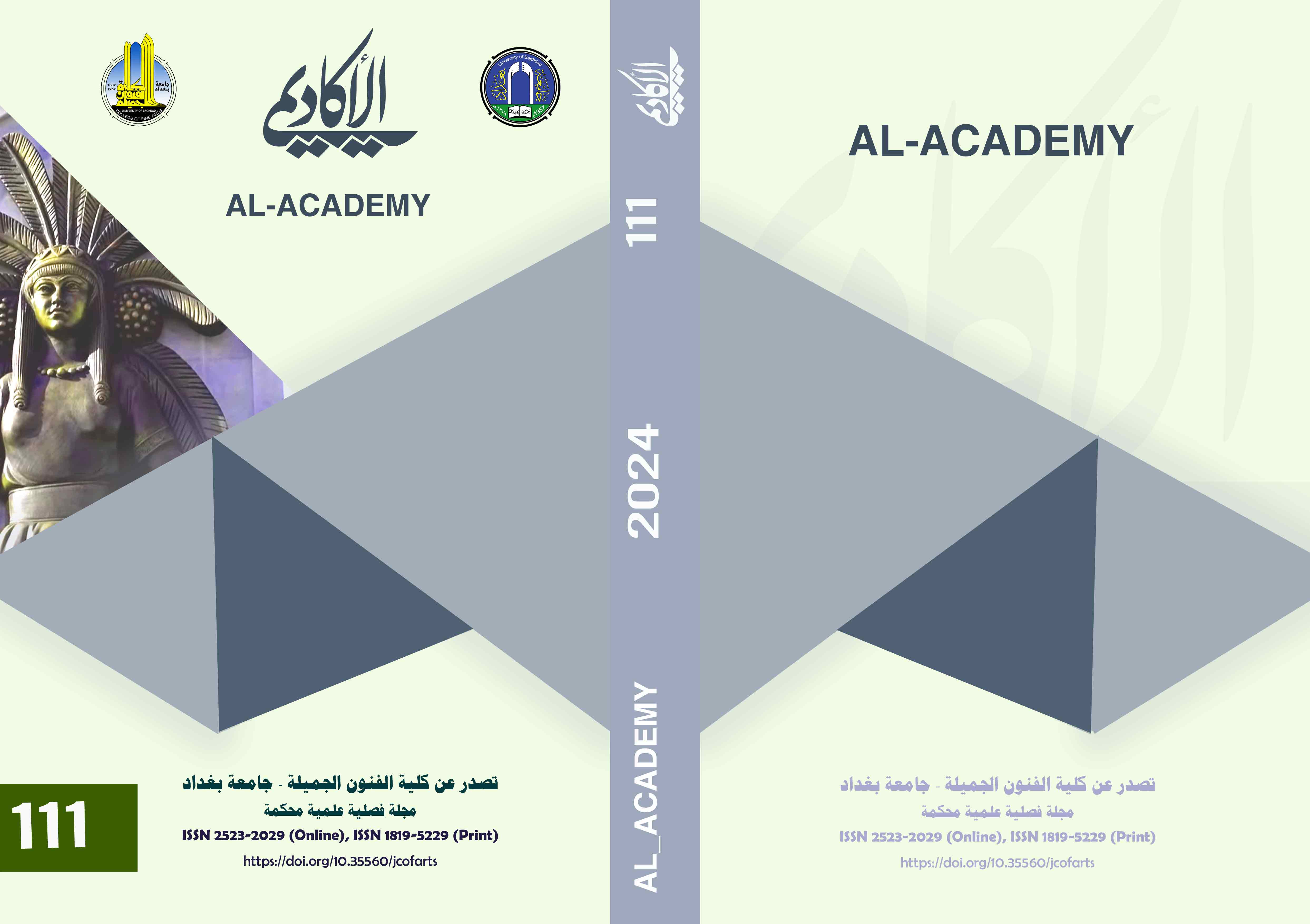التوظيف الفني الخزفي في قصر السلاطين (توب كابى )
DOI:
https://doi.org/10.35560/jcofarts1243الكلمات المفتاحية:
التوظيف، الفن، الخزف، قصر السلاطينالملخص
تعد تركيا واحدة من أهم دول ألعالم الاسلامي التي اشتهرت بالبنى ألمعمارية التاريخية ومنها قصر توب كابى حيث شغل مكانة مهمة في تاريخ العصر العثماني تاركا بصماته بموروث حضاري عريق، عكس فيه أساليب معمارية، علاوة على تنوع الفنون عامة كالتحف الزجاجية والعاجية والمعدنية والخشبية والمنسوجات وكذلك الخزفية بشكل خاص حيث لأقت ازدهارا كبيرا افصحت من خلاله عن نتاجات فنية خزفية عبرت عن رؤية متجانسة بفعل المزاوجة بين الأداء الجمالي الفني والوظيفي، ان قصر توب كابى بنتاجاته الفنية الخزفية للاواني والبلاطات وتنوع اساليبها الزخرفية جاء نتيجة حب السلاطين للفن وشغفهم بجمع التحف الفنية وتجميل عمائرهم ، وهذا ماتم دراسته في البحث الحالي (دراسة التوظيف الفني الخزفي في قصر السلاطين توب كابى وذلك عن طريق دراسة وتحليل لبعض النماذج الفنية الخزفية المختارة في القصر ،وجاءت الدراسة من أربعة فصول، وقد تناول الفصل الاول (الإطار المنهجي) والمتضمن المشكلة التي تمثلت بالسؤال التالي: 1 ماهي الية الاشتغال الفني الخزفي في تصاميم الاساليب الزخرفية قصر السلاطين توب كابى وأهمية البحث وهدف البحث وحدود البحث وتضمن الفصل الثاني (الإطار النظري) الذي ضم ثلاثة مباحث، المبحث الأول :1.الوصف التاريخي لقصر توب كابى2. الوصف المعماري والانشائي للقصر والمبحث الثاني تناول العرض الفني لمقتنيات القصر أما المبحث الثالث فقد انصب على دراسة الخزف في قصر توب كابى. ومؤشرات الاطار النظري ،فيما تضمن الفصل الثالث إجراءات البحث وتحديد مجتمعه وعينته وختم البحث بعرض لنتائج البحث وفهرست المصادر والمراجع.
المراجع
Akshit, I. (2020). Topkapi Palace. (M. Tan, Trans.) Turkey: Akshit Publishing House.
Ali Abdel Aal, D. (2019). Artistic Patterns of Ottoman Decoration. Egypt: Madarat Magazine, Issue 2.
al-Jamal, J. (B.T). Iznik Ceramic Decorations as an Introduction to Enriching the Designs of Women's Dresses. Damietta: Architecture and Arts Magazine.
Amer, M. (2012). Terminology in the Ottoman Empire. Syria: Damascus University, Historical Studies Journal, Issue 117.
Bek asaf, I. (2014). History of the Sultans of Bani Othman. Egypt: Hindawi Foundation.
COŞKUN, B. (2018). Scraping the layers: Tahsin Öz and her stylistic restorations in Topkapı Palace Museum. Turkey: B.N.
DIKER, A. (1915). An Updated Exhibition Venue in the Topkapı Palace Museum. B.M: B.N.
Dimas , A. (2015). Articles on Translation and Communication in Museums. UAE: Sharjah Museums Authority.
El Abidine, M. (2017). Museum Employment of Archaeological Buildings, Topkapi Palace as a Model, Al Benaa Magazine. Retrieved from https://www.academia.edu/7956958/.
ERLER, Z. (2020). Ayasofya ve Topkapı Sarayı Müzesi Bilişsel ve Duygusal. Turkey: Müze Alanya Academic Review Journal Yıl, Vol:4, No:3.
Gharib, Y. (2020). The Ottoman Miniatures. Istanbul: The New Arab Magazine, Issue 2312.
Ghizlan, D. (2016). Painting in Persian and Ottoman Miniatures in the Sixteenth Century AD. Damascus: Damascus University, Master Thesis.
Hadi, B. (1990). A History of Arab Islamic Art. Baghdad: Dar Al-Hikma Press.
Hasnain, a.-S. (2022). The ceramic tiles in the mihrab of the Kashif Mosque in Assiut. Cairo: Heritage and Design Magazine, Issue 9.
Hisham, S. (2008). Mosul's Civilizational Contributions to Islamic Architecture during the Ottoman Era. Baghdad: Journal of Education and Science, Issue 3.
İlgaz, N. (2015). yüzyıl çini pano tasarımlar. İstanbul: Marmara.
Mahmoud, b. (B.T). Symbolic Elements in the Decorations of Industrial Butchery Facilities and Tools in the Ottoman Era. Algeria: Studies in the Antiquities of the Arab World.
Munsterberg, H. (1998). World Ceramics From Prehistoric to Modern Times. B.M: B,N.
Nahas, R. (2016). The Aesthetic Values of the Blue Color Prevailing on Ottoman Ceramic Artifacts. Sultanate of Oman: Journal of Arts and Social Sciences, Sultan Qaboos University Publications.
Namik, ,. H. (2010). Architectural Ornaments in the Ottoman Palaces in the Old City of Nablus. Palestine: An-Najah University, Architectural Engineering, Master Thesis.
Namik, H. (2010). Architectural Ornaments in the Ottoman Palaces in the Old City of Nablus. Palestine: An-Najah University, Architectural Engineering, Master Thesis.
Necipoğlu, G. (1991). Architecture, Ceremonial, and Power: The Topkapi Palace in the Fifteenth and Sixteenth Centuri. New York: The Architectural History Foundation.
Özlü, N. (2018). From imperial palace to museum: The Topkapı Palace during the long Nineteenth Century. Turkey: B.N.
Qadouri, A. (1986). The Museum of Jewelry. Egypt: Alam al-Athar Magazine, Egyptian Antiquities Authority, Issue 30.
Tezcan, S. (2020). Topkapı Sarayı Oğuznamesi. Turkey: Dede Korkut Oguznames.
Tully, A. (2010). Eighteenth-Century Ottoman Princesses at Topkapi Palace. Turkey: B.D.
Uğur, T. (1988). Anadolu-Türk Saray Mimarlığının Evrimi Üzeri Gözlemler (12.-16. Yüzyıl). Turkish: Topkapı Müzesi.
Wagdy, I. (2018). A study of a group of Ottoman marble endowments at the Topkapi Museum. Egypt: Journal of the General Union of Arab Archaeologists, Issue: 19.
التنزيلات
منشور
إصدار
القسم
الرخصة
الحقوق الفكرية (c) 2024 Shaima Ali Fleih Mazban Al-Shammari

هذا العمل مرخص بموجب Creative Commons Attribution 4.0 International License.













